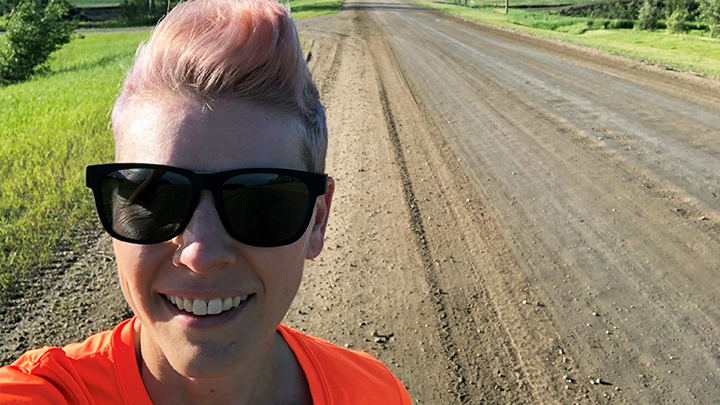
August 11, 2023

Candice Edey is shown here on her first run, six weeks after surgery. Edey donated a kidney anonymously in the spring of 2022. Living organ donation can have a financial impact, however, which is why the AHS Living Donor Wage Replacement Policy grants a paid leave of absence and continuation of benefits to eligible employees for up to a maximum of 12 consecutive weeks for living organ donors, and up to seven consecutive days for surgical bone marrow donors. Photo supplied.
Story by Vanessa Gomez
From a young age, Candice Edey felt inspired to become a living donor, and knew if there were ever an opportunity, she would do it.
“I’ve never had to think about my kidney function. When you hear stories about other people who have to go through dialysis, there’s an impact on their entire circle, including friends and family. Their lives are wrapped around care.” says Edey, Senior Operating Officer, North Zone.
“I’ve been fortunate to be able to cross a lot of things off my bucket list, including ultramarathons and having children and I wanted to give someone else that same opportunity to cross a few things off their bucket list, as well.”
For individuals living with chronic kidney disease, kidney transplantation is widely recognized as the best treatment for individuals who require kidney-replacement therapy (e.g., hemodialysis). Recipients feel healthier, live longer than dialysis patients, have greater freedom to travel and can get back to work, among many benefits.
Edey began the long process to match with someone who needed a kidney through the Kidney Paired Donation Program.
Since kidneys from a living donor tend to last longer in comparison to kidneys from a deceased donor, living kidney donation is preferred — and provides better health outcomes and greater long-term benefits.
“I had a lot of mixed reactions from friends and family when I shared I was pursuing anonymous donation —and I was aware of the physical risks and some of the financial barriers,” she adds.
Recovery time and lost wages can be barriers for people who wish to become a living donor.
“The financial burden to living kidney donation has been reported widely, with estimates of financial impact to living kidney donors of thousands of dollars per donor,” says Dr. Scott Klarenbach, a nephrologist and health economist. “This may be a barrier for individuals to become a living kidney donor — and is arguably an unjust financial burden.”
Alberta Health Services’ (AHS) Living Donor Wage Replacement Policy came into effect in 2019. The former Kidney Health Strategic Clinical Network (SCN) — now known as the Kidney Health Section, Medicine SCN — and AHS Human Resources collaborated on the creation of the policy, which addresses the economic hardships associated with salary loss for AHS employees who step up as living organ donors.
The policy grants a paid leave of absence and continuation of benefits to eligible employees for up to a maximum of 12 consecutive weeks for living organ donors, and up to seven consecutive days for or surgical bone marrow donors.
Edey made her anonymous kidney donation in the spring of 2022, with the support and care of her family, friends and colleagues.
“I was aware of the policy and it was reassuring to know you can access that,” says Edey. “It took the stress out of recovery and was one less thing to worry about.”
To date, the policy has supported 18 participants who became living donors. AHS hopes to inspire other organizations to adopt similar policies to support their employees.
The policy also garnered recognition by the Canadian Society of Transplantation’s (CST) Living Donor Circle of Excellence — a collaboration with the American Society of Transplantation for supporting living donation by providing lost wages to eligible donors.
To be eligible in the Circle of Excellence, organizations must provide salary support for a minimum of four weeks, and wage support of at least 80 per cent. Companies may also elect to give greater support and confirm their activity annually with a report to the CST.
Edey is grateful she had the opportunity to help another individual in a big way.
“It’s not just one person receiving the benefit, but it’s a whole group, including friends and family. I feel really blessed I was in a position to give another human being a chance at a new life.”
For information on organ and tissue donation, as well as living donation, visit MyHealth.Alberta.ca.